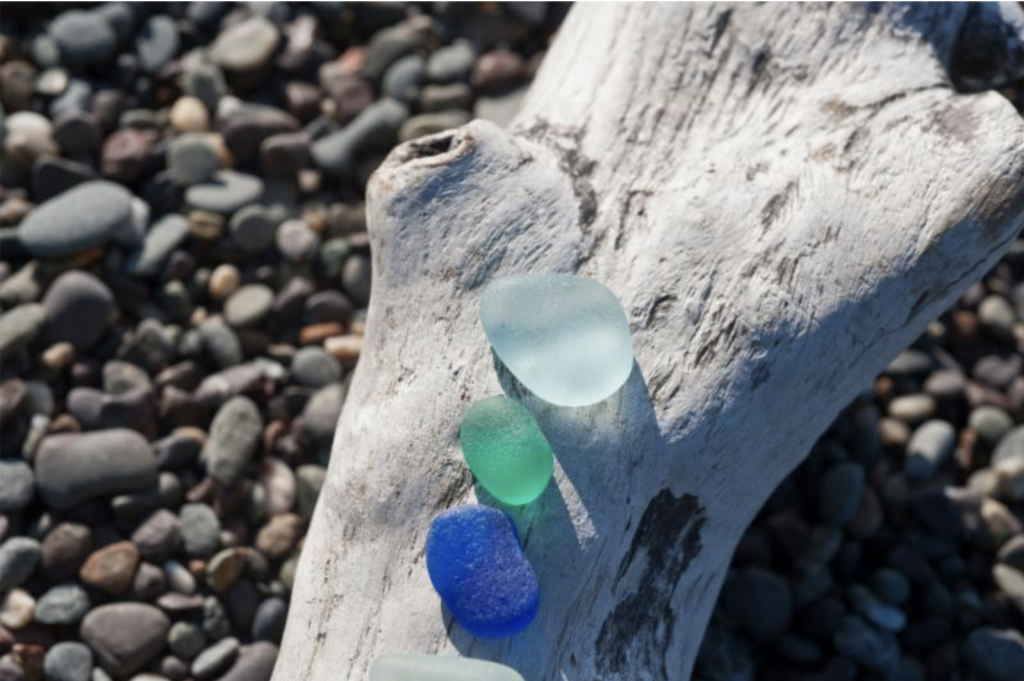SEA GLASS
Gems of the Ocean
Beachcombing is one of the most fun, family friendly activities to do while here at the Maine Beaches, and one of the greatest treasures you can find is sea glass. Whether you are simply a curious wanderer exploring our shores, or an avid hunter of this highly sought-after gem, the article below is full of great information on what it is, where you can find it here, and some tips for making your endeavor a successful one!

What is sea glass?
Sea glass is physically and chemically weathered glass found on beaches along bodies of salt water that produces a distinct natural frosted glass with softened edges. Sea glass takes 20 to 40 years, and sometimes as much as 100 years, to acquire its characteristic texture and shape. True sea glass originates as pieces of glass from broken bottles, broken tableware, or even shipwrecks, which are rolled and tumbled in the ocean for years until all of their edges are rounded off, and the slickness of the glass has been worn to a frosted appearance.
The color of sea glass is determined by its original source. Most sea glass comes from bottles, but it can also come from jars, plates, windows, windshields, ceramics or sea pottery. The most common colors of sea glass are kelly green, brown, white, and clear. Less common colors include jade, amber, forest green, and ice- or soft blue. Uncommon colors of sea glass include a type of green, which comes primarily from early to mid-1900s and beer bottles. Purple sea glass is also very uncommon, as is citron, opaque white, cobalt and cornflower blue, and aqua. Extremely rare colors include gray, pink, black, yellow, turquoise, red, and orange.
How do you find it?
The best time to search and find sea glass is after a storm or strong weather event, when the surf churns strongly and unearths pieces of sea glass from the ocean floor and whisks it to shore. Additionally, searching during low tide (particularly around the full moon), is likely to yield better results. Sea glass is more prevalent on beaches that are pebbly or rocky, vs. long and sandy (which are features of our two regional beaches described below), so wearing walking or beach shoes to navigate around the rough surface is advised. The glass can be found among and between larger rocks and tide pools, as well as along the shore. You may want to bring a small rake or scoop to sift through the sand, and you’ll also want to bring a container to collect your finds. A couple of other insider tips to consider:
- Face away from the sun and look for sparkles along the sand and among the rocks
- Sea glass can also be found in shallow water, so wading along the shore might lead to some discovery
- If you find sea glass where the edges aren’t fully softened, it’s not quite ready and should be returned to the ocean
Where can you find sea glass in the Maine Beaches?
While sea glass can be found in many places along the coastline of Maine, the southern Maine Beaches region is home to two recognized sea glass hot spots. If you are visiting and searching for sea glass in the region, we recommend either spring or fall, which are both seasons where we see less beach foot traffic, yet are still warm and uncovered enough to find the glass.
Middle Beach, Kennebunk: The string of beaches, Mother’s, Middle and Gooch’s, that stretch along Beach Avenue from Gooch’s Beach past Lord’s Point are connected by sidewalks. It is approximately 1 1/2 miles from the far end of Gooch’s Beach to Lord’s Point, with Middle Beach located, of course, in the middle!
Fortune’s Rock Beach, Biddeford: This two-mile beach runs from Biddeford Pool to Fortune’s Rocks. The southernmost end is where you’ll be most likely to find the most sea glass. Limited parking is available at both the southern end and northern end of the beach, accessible from Fortunes Rocks Road.
Here’s to happy hunting and fabulous finds!
- Ogunquit In A Seashell: An Insider’s Guide To Maine Beachcombing
- Sea Glass Beaches in Maine
- The Sea Glass Center, Kennebunk, Maine
- The North American Sea Glass Association
